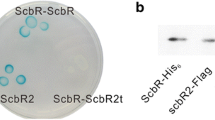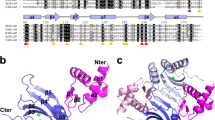Abstract
With primers designed for the conserved region of the γ-butyrolactone autoregulator receptor proteins from Streptomyces species, PCR using the Streptomyces clavuligerus genome DNA as a template gave a clear band of 100 bp, the sequence of which revealed high similarity to the expected region of a receptor gene. By Southern blot and colony hybridization with the 100-bp insert as a probe, plasmid pSCA, harboring a 4.2 kb-SalI fragment, was obtained. Sequence analysis on the insert revealed a 702-bp ORF encoding a protein with a moderate similarity (identity, 33–43%; similarity, 51–62%) to known γ-butyrolactone autoregulator receptor proteins from Streptomyces sp. The ORF was named scaR (S. clavuligerus autoregulator receptor). The scaR/pET-3d plasmid was constructed for overexpression of the recombinant ScaR protein (rScaR) in Escherichia coli, and the rScaR protein was purified to homogeneity by DEAE-ion-exchange HPLC. The molecular mass of the purified rScaR protein was determined to be 27 kDa as determined by SDS-PAGE, and 54 kDa by gel filtration HPLC under nondenatured conditions at a low protein concentration, indicating that the majority of the native ScaR is present in the form of a dimer, although rScaR tended to aggregate into a higher molecular form of 230 kDa at a high protein concentration. A binding assay with tritium-labeled autoregulators indicated that IM-2 type compounds with a long C2 side chain were the most effective ligands for rScaR, demonstrating for the first time that the β-lactam producer S. clavuligerus contains a gene for the γ-butyrolactone autoregulator receptor.





Similar content being viewed by others
References
Bibb MJ, Findlay PR, Johnson MW (1984) The relationship between base composition and codon usage in bacterial genes and its use for the simple and reliable identification of protein-coding sequences. Gene 30:157–166
Chakraburtty R, White J, Takano E, Bibb M (1996) Cloning, characterization and disruption of a (p)ppGpp synthetase gene (relA) of Streptomyces coelicolor A3 (2). Mol Microbiol 19:357–368
Grant SG, Jessee J, Bloom FR, Hanahan D (1990) Differential plasmid rescue from transgenic mouse DNAs into Escherichia coli methylation–restriction mutants. Proc Natl Acad Sci USA 87:4645–4649
Gräfe U, Schade W, Eritt I, Fleck WF, Radics L (1982) A new inducer of anthracycline biosynthesis from Streptomyces viridochromogenes. J Antibiot 35:1722–1723
Gräfe U, Reinhardt G, Schade W, Eritt I, Fleck WF, Radics L (1983) Interspecific inducers of cytodifferentiation and anthracycline biosynthesis from Streptomyces bikiniensis and S. cyaneofuscatus. Biotechnol Lett 5:591–596
Hara O, Beppu T (1982) Mutants blocked in streptomycin production in Streptomyces griseus—the role of A-factor. J Antibiot 35:349–358
Hashimoto K, Nihira T, Yamada Y (1992a) Distribution of virginiae butanolides and IM-2 in the genus Streptomyces. J Ferment Bioeng 73:61–65
Hashimoto K, Nihira T, Sakuda S, Yamada Y (1992b) IM-2, a butyrolactone autoregulator, induces production of several nucleoside antibiotics in Streptomyces sp. FRI-5. J Ferment Bioeng 73:449–455
Khokhlov AS (1980) Problems of studies of specific cell autoregulators (on the example of substances produced by some actinomycetes). In: Ananchenko SN (ed) Frontiers of bioorganic chemistry and molecular biology. Pergamon, Oxford, UK, pp 201–210
Kieser T, Bibb MJ, Buttner MJ, Chater KF, Hopwood DA (2000) Practical Streptomyces Genetics. The John Innes Foundation, Norwich, UK
Kim HS, Nihira T, Tada H, Yanagimoto M, Yamada Y (1989) Identification of binding protein of virginiae butanolide C, an autoregulator in virginiamycin production, from Streptomyces virginiae. J Antibiot 42:769–778
Kim HS, Tada H, Nihira T, Yamada Y (1990) Purification and characterization of virginiae butanolide C-binding protein, a possible pleiotropic signal-transducer in Streptomyces virginiae. J Antibiot 43:692–706
Kitani S, Yamada Y, Nihira T (2001) Gene replacement analysis of the butyrolactone autoregulator receptor (FarA) reveals that FarA acts as a novel regulator in secondary metabolism of Streptomyces lavendulae FRI-5. J Bacteriol 183:4357–4363
Kleiner EM, Pliner SA, Soifer VS, Onoprienko VV, Balashova TA, Rosynov BV, Khokhlov AS (1976) The structure of A-factor, a bioregulator from Streptomyces griseus. Bioorg Khim 2:1142–1147
Kondo K, Higuchi Y, Sakuda S, Nihira T, Yamada Y (1989) New virginiae butanolide from Streptomyces virginiae. J Antibiot 42:1873–1876
Mizuno K, Sakuda S, Nihira T, Yamada Y (1994) Enzymatic resolution of 2-acyl-3-hydroxymethyl-4-butanolide and preparation of optically active IM-2, the autoregulator from Streptomyces sp. FRI-5. Tetrahedron 50:10849–10858
Mori K (1983) Revision of the absolute configuration of A-factor. Tetrahedron 39:3107–3109
Nihira T, Shimizu Y, Kim HS, Yamada Y (1988) Structure–activity relationships of virginiae butanolide C, an inducer of virginiamycin production in Streptomyces virginiae. J Antibiot 41:1828–1837
Okamoto S, Nakamura K, Nihira T, Yamada Y (1995) Virginiae butanolide binding protein from Streptomyces virginiae. J Biol Chem 270:12319–12326
Onaka H, Ando N, Nihira T, Yamada Y, Beppu T, Horinouchi S (1995) Cloning and characterization of the A-factor receptor gene from Streptomyces griseus. J Bacteriol 177:6083–6092
Rao RN, Richardson MA, Kuhstoss S (1987) Cosmid shuttle vectors for cloning and analysis of Streptomyces DNA. Methods Enzymol 153:166–198
Reading C, Cole M (1977) Clavulanic acid: a beta-lactamase-inhiting beta-lactam from Streptomyces clavuligerus. Antimicrob Agents Chemother 11:852–857
Ruengjitchatchawalya M, Nihira T, Yamada Y (1995) Purification and characterization of the IM-2-binding protein from Streptomyces sp. Strain FRI-5. J Bacteriol 177:551–557
Sakuda S, Yamada Y (1991) Stereochemistry of butyrolactone autoregulators from Streptomyces. Tetrahedron Lett 32:1817–1820
Sambrook J, Russell DW (2001) Molecular cloning: a laboratory manual, 3rd edn. Cold Spring Harbor Laboratory, Cold Spring Harbor
Sanger F, Nicklen S, Coulson AR (1977) DNA sequencing with chain-terminating inhibitors. Proc Natl Acad Sci USA 74:5463–5467
Sato K, Nihira T, Sakuda S, Yamagimoto M, Yamada Y (1989) Isolation and structure of a new butyrolactone autoregulator from Streptomyces sp. FRI-5. J Ferment Bioeng 68:170–173
Studier FW, Moffat BA (1986) Use of bacteriophage T7 RNA polymerase to direct selective high-level expression of cloned genes. J Mol Biol 189:113
Studier FW, Rosenberg AH, Dunn JJ, Dubendorff JW (1990) Use of T7 RNA polymerase to direct expression of cloned genes. Methods Enzymol 185:60–89
Takano E, Nihira T, Hara Y, Jones JJ, Gershater CJL, Yamada Y, Bibb M (2000) Purification and structural determination of SCB1, a γ-butyrolactone that elicits antibiotic production in Streptomyces coelicolor A3(2). J Biol Chem 275:11010–11016
Takano E, Chakraburtty R, Nihira T, Yamada Y, Bibb M (2001) A complex role for the γ-butyrolactone SCB1 in regulating antibiotic production in Streptomyces coelicolor A3(2). Mol Microbiol 41:1015–1028
Waki M, Nihira T, Yamada Y (1997) Cloning and Characterization of the gene (farA) encoding the receptor for an extracellular regulatory factor (IM-2) from Streptomyces sp. Strain FRI-5. J Bacteriol 179:5131–5137
Yamada Y, Sugamura K, Kondo K, Yanagimoto M, Okada H (1987) The Structure of inducing factors for virginiamycin production in Streptomyces virginiae. J Antibiot 40:496–504
Yanagimoto M, Enatsu T (1983) Regulation of a blue pigment production by Q-nonalactone in Streptomyces sp. J Ferment Technol 61:545–550
Yanagimoto M, Terui G (1971) Physiological studies on staphylomycin production. (II) Formation of a substance effective in inducing staphylomycin production. J Ferment Technol 49:611–618
Acknowledgments
This work was supported in part by a grant (KRF-2002-042-C00086) from the Korea Research Foundation, and by a grant from the Ministry of Agriculture, Forestry and Fisheries of Japan.
Author information
Authors and Affiliations
Corresponding author
Rights and permissions
About this article
Cite this article
Kim, H.S., Lee, Y.J., Lee, C.K. et al. Cloning and characterization of a gene encoding the γ-butyrolactone autoregulator receptor from Streptomyces clavuligerus. Arch Microbiol 182, 44–50 (2004). https://doi.org/10.1007/s00203-004-0697-x
Received:
Revised:
Accepted:
Published:
Issue Date:
DOI: https://doi.org/10.1007/s00203-004-0697-x




